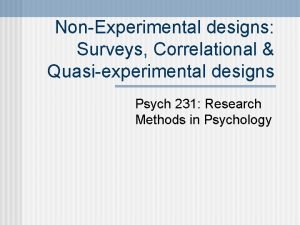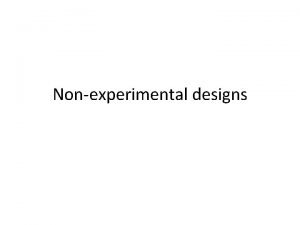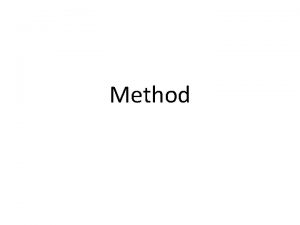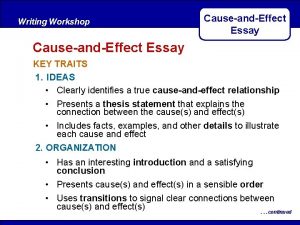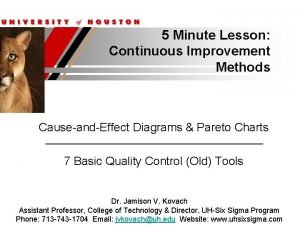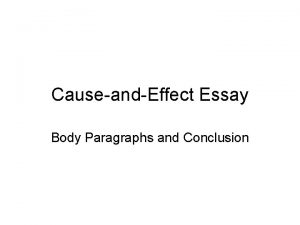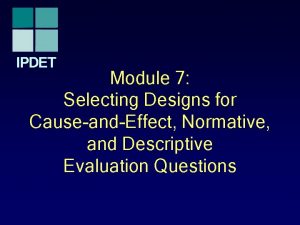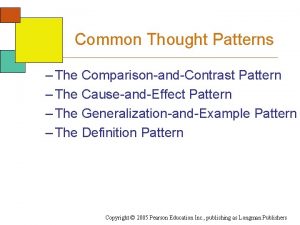Experimental Research Experimental Research Can demonstrate causeandeffect very



















- Slides: 19

Experimental Research

Experimental Research • Can demonstrate cause-and-effect very convincingly • Very stringent research design requirements • Experimental design requires: » Random assignment to groups (experimental and control) » Independent treatment variable that can be applied to the experimental group » Dependent variable that can be measured in all groups

Fundamentals of Experimental and Quasi. Experimental Research • Random selection and random assignment : » Distinguish between “selection” and “assignment” » Random selection helps to assure population validity » If you incorporate random assignment Experimental research » If you do not use random assignment Quasi-experimental research

Fundamentals of Experimental and Quasi. Experimental Research (cont’d. ) • When to use experimental research design : » If you strongly suspect a cause-and-effect relationship exists between two conditions, and » The independent variable can be introduced to participants and can be manipulated, and » The resulting dependent variable can be measured for all participants

Internal and External Validity • “Validity of research” refers to the degree to which the conclusions are accurate and generalizable • Both experimental and quasi-experimental research are subject to threats to validity • If threats are not controlled for, they may introduce error into the study, which will lead to misleading conclusions

Threats to External Validity • External validity—extent to which the results can be generalized to other groups or settings » Population validity—degree of similarity among sample used, population from which it came, and target population » Ecological validity—physical or emotional situation or setting that may have been unique to the experiment » If the treatment effects can be obtained only under a limited set of conditions or only by the original researcher the findings have low ecological validity.

Threats to External Validity • Selection bias. – If sample is biased you cannot generalize to the population. • Reactive effects. – Experimental setting. • Differs from natural setting. – Testing. • Pretest influences how subjects respond to the treatment. • Multiple-treatment inference. – If the subjects are exposed to more than one treatment, then the findings could only be generalized to individuals exposed to the same treatments in the same order of presentation.

Threats to Internal Validity • Internal validity—extent to which differences on the dependent variable are a direct result of the manipulation of the independent variable » History—when factors other than treatment can exert influence over the results; problematic over time » Maturation—when changes occur in dependent variable that may be due to natural developmental changes; problematic over time » Testing—pretest may give clues to treatment or posttest and may result in improved posttest scores » Instrumentation – Nature of outcome measure has changed.

Threats to Internal Validity (cont’d. ) » Regression – Tendency of extreme scores to be nearer to the mean at retest » Differential selection of participants—participants are not selected/assigned randomly » Attrition (mortality)—loss of participants » Experimental treatment diffusion – Control conditions receive experimental treatment.

Experimental and Quasi-Experimental Research Designs • Commonly used experimental design notation : » X 1 = treatment group » X 2 = control/comparison group » O = observation (pretest, posttest, etc. ) » R = random assignment

Common Experimental Designs • Single-group pretest-treatment-posttest design: O X O » Technically, a pre-experimental design (only one group; therefore, no random assignment exists) » Overall, a weak design » Why?

Common Experimental Designs (cont’d. ) • Two-group treatment-posttest-only design: R R X 1 X 2 O O » Here, we have random assignment to experimental, control groups » A better design, but still weak—cannot be sure that groups were equivalent to begin with

Common Experimental Designs (cont’d. ) • Two-group pretest-treatment-posttest design: R O X 1 O R O X 2 O » A substantially improved design—previously identified errors have been reduced

Common Experimental Designs (cont’d. ) • Solomon four-group design: R O X 1 O R O X 2 O R X 1 O R X 2 O » A much improved design—how? ? » One serious drawback—requires twice as many participants

Common Experimental Designs (cont’d. ) • Factorial designs: R O X 1 g 1 O R O X 2 g 1 O R O X 1 g 2 O R O X 2 g 2 O » Incorporates two or more factors » Enables researcher to detect differential differences (effects apparent only on certain combinations of levels of independent variables)

Common Experimental Designs (cont’d. ) • Single-participant measurement-treatment-measurement designs: O O O | X O | O O O » Purpose is to monitor effects on one subject » Results can be generalized only with great caution

Common Quasi-Experimental Designs • Posttest-only design with nonequivalent groups: X 1 O X 2 O » Uses two groups from same population » Questions must be addressed regarding equivalency of groups prior to introduction of treatment

Common Quasi-Experimental Designs (cont’d. ) • Pretest-posttest design with nonequivalent groups: O X 1 O O X 2 O » A stronger design—pretest may be used to establish group equivalency

Similarities Between Experimental and Quasi-Experimental Research 1. Cause-and-effect relationship is hypothesized 2. Participants are randomly assigned (experimental) or nonrandomly assigned (quasi-experimental) 3. Application of an experimental treatment by researcher 4. Following the treatment, all participants are measured on the dependent variable 5. Data are usually quantitative and analyzed by looking for significant differences on the dependent variable
 Disadvantages of experimental research
Disadvantages of experimental research He can speak english
He can speak english Very bad to very good scale
Very bad to very good scale Multiplication of scientific notation
Multiplication of scientific notation There is very few soup in the bowl
There is very few soup in the bowl Receiving table/area
Receiving table/area Very little very few
Very little very few Experimental vs non experimental
Experimental vs non experimental Solomon four group design
Solomon four group design Non experimental design vs experimental
Non experimental design vs experimental Nonexperimental study
Nonexperimental study Research instrument in experimental research
Research instrument in experimental research Research instrument in experimental research
Research instrument in experimental research Without grammar very little can be conveyed
Without grammar very little can be conveyed Without grammar very little can be conveyed
Without grammar very little can be conveyed Blood can be very bad
Blood can be very bad Repetition scheme
Repetition scheme The contest at mount carmel summary
The contest at mount carmel summary Edip method
Edip method Bicultural couples tend to demonstrate extremes in
Bicultural couples tend to demonstrate extremes in
